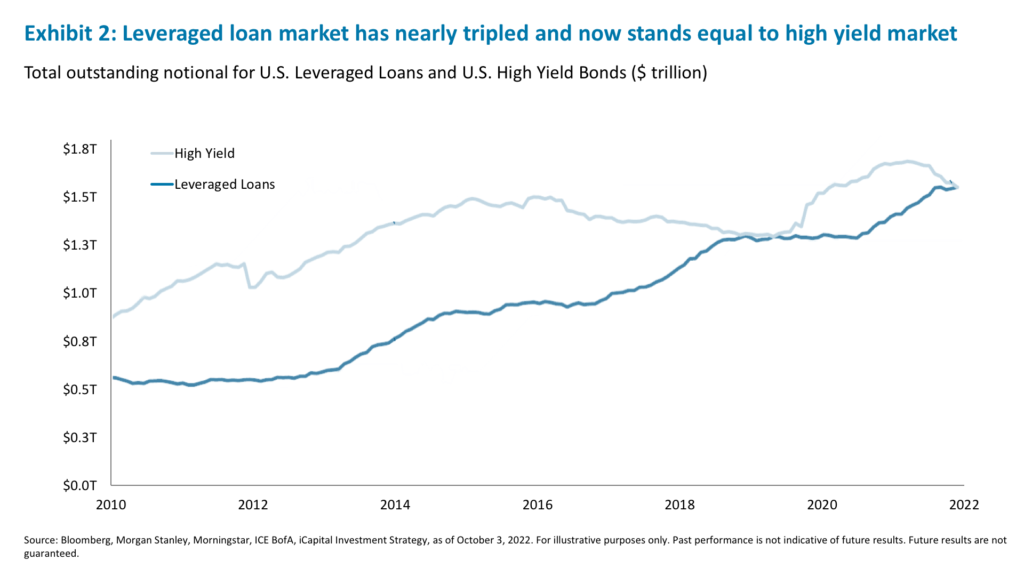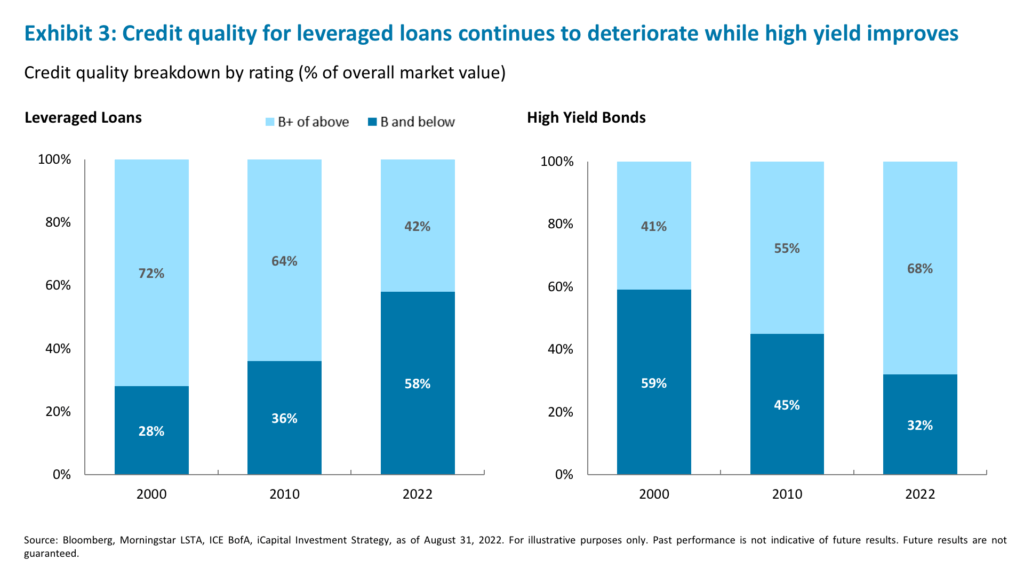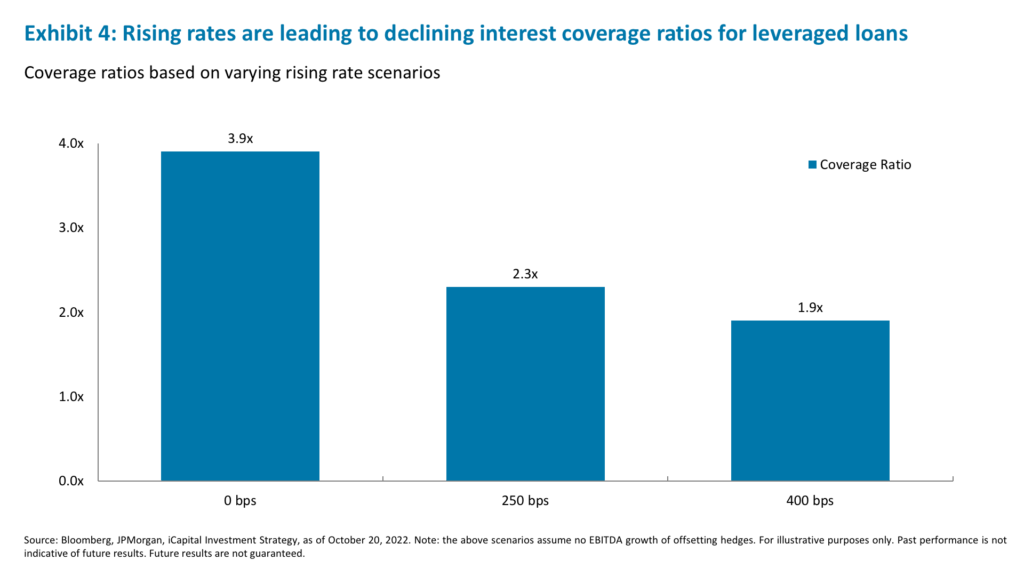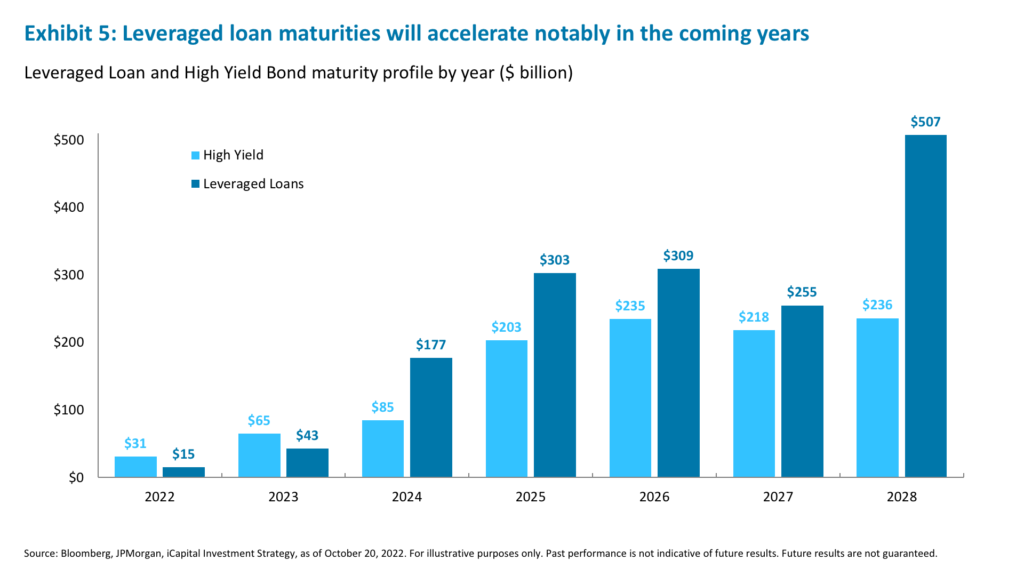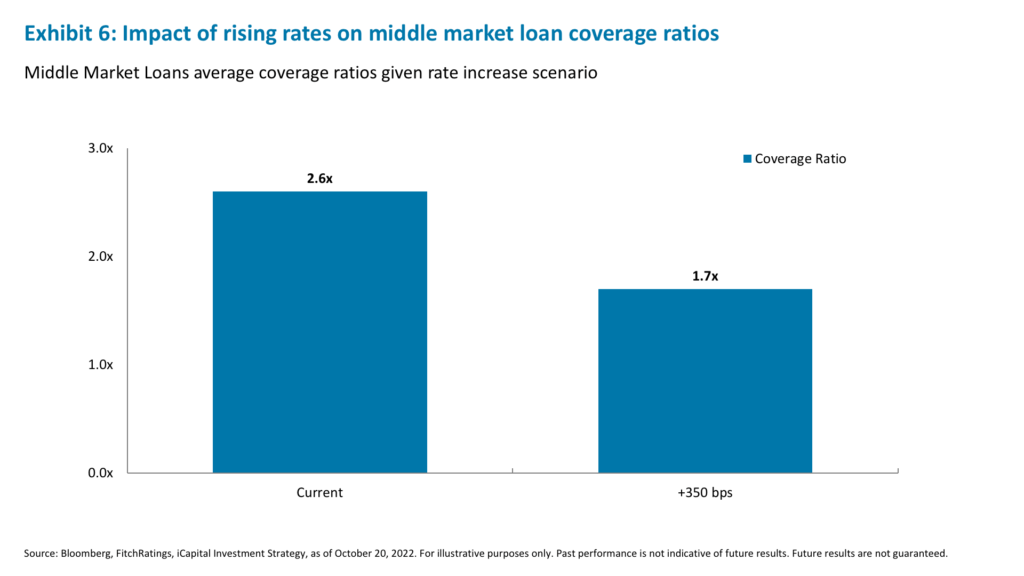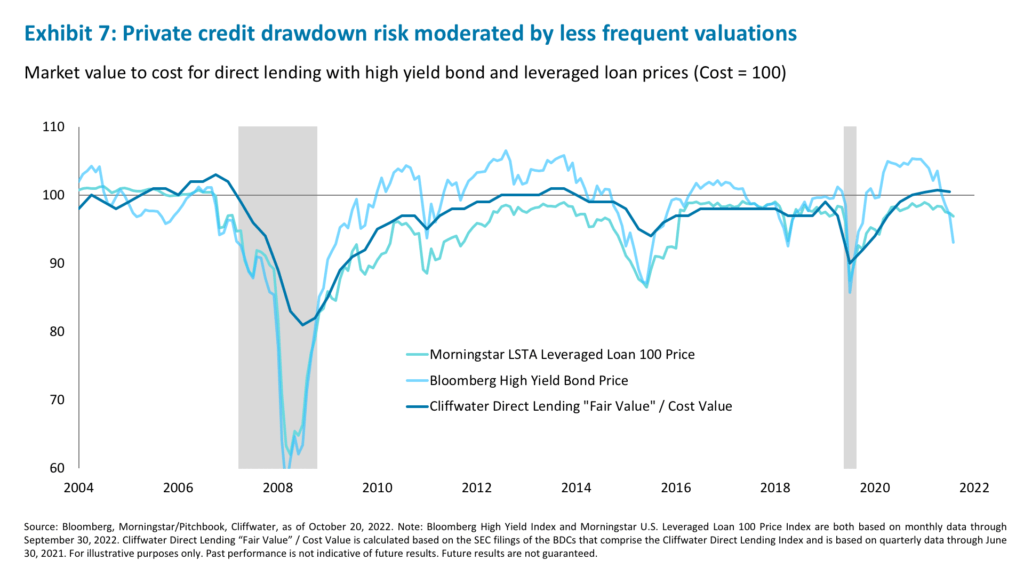Another week brings another reset higher in Fed fund rate (FFR) expectations. Fed policy has been the driver of markets this year and effectively set the hurdle rate investments need to overcome to prove attractive to investors. At present, the expected FFR by Q1 ’23 is now approaching 5% (4.96% to be exact), up from 4.5% two weeks ago.1 As long as recession uncertainty is swirling and dampening the outlook for stocks, for investors it’s all about income and getting paid while you wait. So where can investors still get cash-beating income returns? With high yield, leveraged loans, and private credit all yielding in the range of 9-11%,2 the question remains – which one is best? Leveraged loans have far outshined all other fixed income assets this year, but in this week’s commentary, we explore why now might be the right time to re-allocate from publicly traded leveraged loans to a barbell of high yield and private credit.
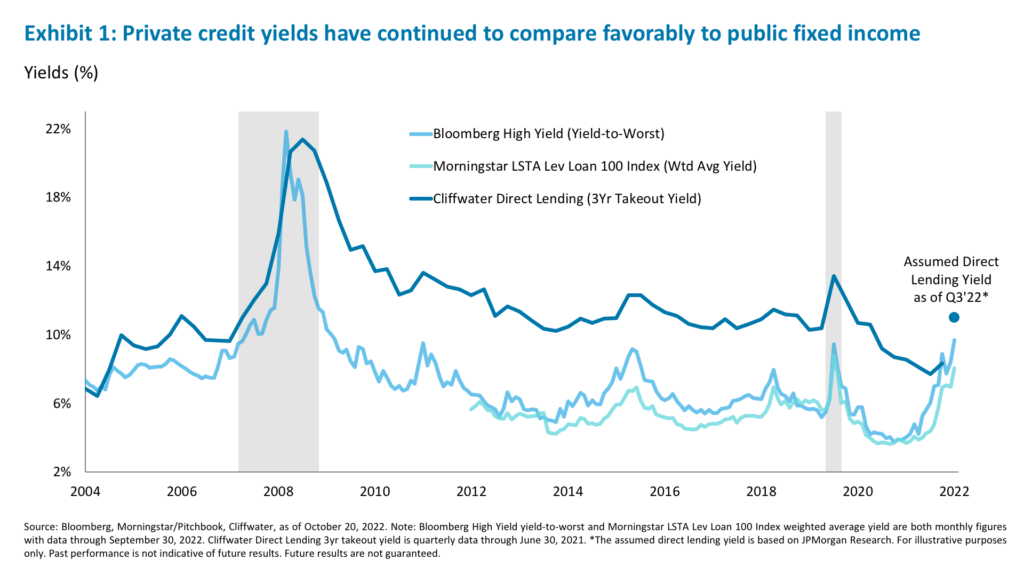
Leveraged loans have outperformed this year, but now the risks are building
Leveraged loans (LL), as proxied by the Morningstar LSTA U.S. Leveraged Loan Index, has been the best performing fixed income sub-asset class this year, delivering a -2.4% total return compared with a -13.6% return for U.S. High Yield bonds (HY) and -15.6% for Bloomberg Aggregate Bond Index.3 Meanwhile, loan prices have fallen to roughly $92 (92 cents on the dollar) after reaching a post-global financial crisis high of $99 back in January, but zero interest rate duration and coupons rising in tandem with interest rates have aided in their outperformance over the broader fixed income group.4
Looking out to 2023 and beyond, however, investors are increasingly scrutinizing the credit quality of borrowers amidst the potential recessionary environment and the impact that higher rates will have. Leveraged loans appear vulnerable for three key reasons:
1. Huge ramp-up in loan issuance has increasingly come from lower quality borrowers.
The U.S. leveraged loan market has nearly tripled in size in the past 15 years from around $500 billion in outstanding notional in 2007 to $1.4 trillion today.5 At present, the size of the loan market is now roughly equivalent to that of the U.S. high yield market whose growth pales in comparison – growing outstanding notional by less than 15% since 2014 (Exhibit 2).6
Meanwhile, the loan market expansion has come in the form of deteriorating credit quality, with the overall composition shifting down to the B and below quality bucket. Currently, 58% of all loans have an issuer rating of B and below, up from 36% in 2010 and 28% in 2000 (Exhibit 3).7 By contrast, the high yield index fundamentals look healthier and have improved with the share of B and below borrowers declining to 32% in 2022 compared to 45% in 2010 and 59% in 2000 – essentially moving in the opposite direction of the loan market.8
Another sign of better HY fundamentals is that leverage for HY bond-only issuers is below that of loan-only and loan-and-bond issuers.9 The debt to EBITDA ratio for bond-only issues is 3.44x vs. 5.16x for loan-only, and 6.12x for loan-and-bond issuers.10 This higher leverage and increasing debt service due to rising rates is a particular concern for floating-rate leveraged loan borrowers, where a potential recession and higher interest costs could materially and adversely affect company financials.
2. Steep and quick ramp-up in rates will lead to lower interest coverage ratios.
In our earlier post on leveraged loans back in May 2022 (here), we highlighted that assuming rates rose 250bps, interest rate coverage ratios would likely fall from but remain sufficiently adequate to meet interest expenses.11 At the time of the writing, few were expecting the Fed to hike the fed funds rate to 4.5% – as implied by current market-pricing – by the end of this year.12 Since that note, the market has priced in an additional 200bps of tightening, bringing the total change to 450bps.13 If market-pricing is correct, this will mean that the Fed Funds rate will have risen roughly 425bps in less than one-years’ time.14 For comparison, it took around two years to raise rates to this extent during the 2004 – 2006 rate hiking cycle.15
The steep ramp-up in rates over the past few months means a change to the interest coverage math. Assuming no EBITDA growth or offsetting hedges, we believe coverage ratios will likely fall to 1.9x vs. 2.3x that was initially modeled in May.16 This also means that 31.5% of the loan borrowers could see their interest rate coverage ratios decline to sub-1.5x17, potentially leading to an inability to meet its interest cost obligations. Importantly, the analysis here assumes no change in EBITDA and a soft-landing scenario, both of which we doubt now are achievable. Therefore, in an earnings downdraft and a recessionary scenario the outcomes could be worse.
3. An upcoming wall of maturities is another reason for caution in leveraged loans.
Robust new issuance since the GFC will mean leveraged loan maturities will accelerate in the coming years. Issuance has been particularly strong since 2017 – the average annual leveraged loan issuance between 2017 and 2021 was $430 billion vs $261 billion between 2007 and 2016.18 Considering this and the fact that the average term to maturity on these loans is five to seven years, an increasing amount of loans will need to be repaid or refinanced in the next few years.19 Although only $15 billion of loans are due in 2022, that amount begins to step up to $43 billion in 2023 and $177 billion in 2024, well outpacing the maturities upcoming in HY (Exhibit 5).20
This coming ramp-up in maturities at the time when economic conditions are deteriorating could raise the probability of defaults in the leveraged loans space. In fact, close to half of all high-yield bond and loan defaults by volume occurs when maturity walls are under two-three years away.21 Looking ahead, leveraged loan defaults are now expected to rise from today’s rate of 0.8% to a range of 2%-3% in 2023 and a range of 3%-4% in 2024 – above the 15-year average of 2.5%.22 In contrast, high yield defaults are expected to rise to 2.5%-3.5% and 3.0%-4.0% in 2023 and 2024, respectively, but remain below their long-run average of 3.8%.23
Consider a barbell strategy of high yield bonds and private middle market loans
Given the risks to the leveraged loan market outlined above, investors might be better served to re-allocate their leveraged loan exposure to a barbell of publicly traded high yield and private middle market loans.
High yield underperformed sharply this year. Of course, these bonds carry duration risks as their coupons are fixed rate. But with the futures implied Fed funds rate approaching 5% by March of 2023, we think that a lot has been priced into rates – which means that duration risk in high yield is now lower if 10-year rates can pause around this 4% level and the upside from higher floating rates in leveraged loans is also limited.24
Credit risk is the key concern now for both HY and LL. We would expect spreads on both to widen as the economy deteriorates, but the credit quality of HY and insulation from higher rates should provide more cushion to HY investors than LLs.
Turning to private credit, while we have similar credit quality concerns about private middle market loans as we do about publicly traded leveraged loans due to their floating rate nature, we also see more potential mitigants of those concerns, which we will detail below.
These loans are issued to smaller, potentially less economically resilient, higher credit risk companies. For example, the median EBITDA of these companies is $24 million.25 And the median adjusted debt was about $175 million, which makes the leverage ratio for a middle market loan of over 7x EBITDA, well in excess of HY and above that of LL.26
As a result, 76% of these loans have a credit rating estimated to be B- , with 13% CCC+ and below.27 Also, Fitch estimates that for the 184 middle market loan issuers they cover the median 2022 EBITDA/interest coverage was 2.6x, but could decline to 1.7x with 350bps of rate increase.28 And with more than 425bps on deck for the full year, the metric would deteriorate further.29
Despite these concerns, we would maintain our allocation to direct lending (at the expense of LL) as private credit managers have more levers to pull to help navigate the likely rising default environment, and the buy-and-hold nature of these loans can help insulate investors from market dislocations.
1. History suggests that we should expect the conventional default rates on middle market loans to rise slightly more than the broadly syndicated loans although not meaningfully so. But, in practice, direct lending managers may negotiate privately with borrowers and private equity sponsors to shore up support for the companies, employ payment-in-kind (PIK) strategies – borrower amends interest payments from cash to PIK and, in doing so, pays for their interest in the form of a larger equity stake to the lender – and avoid conventional default. As a result of these measures, during the COVID crisis the conventional default rates middle market loans was ~2.5% or half of those of LLs because of these measures, although the overall conventional and selective defaults were reported at 8% when accounting for these measures.30
2. Since middle market loans are not publicly traded, they are not subject to technical market dislocations. It’s not a secret that liquidity in markets – equities, Treasuries, and credit – evaporates at the time when you need it most – when volatility spikes. This leads to pricing that is not necessarily indicative of fundamental value, but is driven by daily market technicals and can result in large gaps down in pricing. This dynamic does not exist in private credit. The buy-and-hold nature of middle market loans means that investors can focus on receiving the cash flows without being at the whim of daily trading and market dislocations.
The lack of public trading may mean that the reported “fair value” of middle market loans does not always reflect current market conditions and gets marked to market with a lag. But our view is that private credit’s role in the portfolio is to provide an attractive stream of income and return of principle over time, thus we are not as concerned about potentially “stale” valuations. As rates have risen, so too should the coupons on middle market loans. Given that the average spread on middle market loans tends to be roughly 500bps over LIBOR (and now SOFR),31 the coupon should increase from 6.5% on June 30, 2022, to 8% at the end of September and 9.5% by year-end.32
Conclusion
While the environment remains challenging for equity risk-taking despite the latest rally, we are encouraged by the opportunity in parts of fixed income highlighted above. These won’t be immune to a recession, and we fully expect that spreads on high yield could go wider still in that event. However, the ability to earn a very healthy income stream and offset at least a portion of a potential decline in market value should be appealing for many portfolios.
1. Bloomberg, iCapital Investment Strategy, as of October 19, 2022.
2. Bloomberg, iCapital Investment Strategy, as of October 19, 2022.
3. Bloomberg, iCapital Investment Strategy, as of October 19, 2022.
4. Bloomberg, JPMorgan, iCapital Investment Strategy, as of October 19, 2022.
5. S&P Global, LCD, iCapital Investment Strategy, as of October 2022.
6. S&P Global, as of October 3, 2022.
7. S&P Global, LCD, iCapital Investment Strategy, as of August 31, 2022.
8. ICE BofA, iCapital Investment Strategy, as of August 31, 2022.
9. JPMorgan Credit Research, as of April 19, 2022
10. JPMorgan Credit Research, as of April 19, 2022
11. JPMorgan Credit Research, as of April 19, 2022
12. Bloomberg, iCapital Investment Strategy, as of October 19, 2022.
13. Bloomberg, iCapital Investment Strategy, as of October 19, 2022.
14. Bloomberg, iCapital Investment Strategy, as of October 19, 2022.
15. Bloomberg, iCapital Investment Strategy, as of October 19, 2022.
16. JPMorgan Credit Research, as of April 19, 2022
17. JPMorgan Credit Research, as of April 19, 2022
18. Morningstar LSTA, LCD, as of October 3, 2022.
19. International Monetary Fund, as of January 2017.
20. Bloomberg, Morningstar LSTA, JPMorgan, as of October 2022.
21. Fitch, as March 14, 2022.
22. Fitch, as of September 30, 2022.
23. Fitch, as of October 18, 2022. Note: long-run average is based on the prior 21-years.
24. Bloomberg, iCapital Investment Strategy, as of October 20, 2022.
25. S&P Global Ratings, as of October 13, 2022
26. S&P Global Ratings, as of October 13, 2022
27. S&P Global Ratings, as of October 13, 2022
28. Fitch, as of December 7, 2021.
29. Fitch, as of December 7, 2021.
30. S&P Global Ratings, as of Oct 13, 2022
31. S&P Global Ratings, as of July 31, 2022
32. Bloomberg, iCapital Investment Strategy, as of October 24, 2022.
IMPORTANT INFORMATION
The material herein has been provided to you for informational purposes only by iCapital, Inc. (“iCapital”). This material is the property of iCapital and may not be shared without the written permission of iCapital. No part of this material may be reproduced in any form, or referred to in any other publication, without express written permission of iCapital.
This material is provided for informational purposes only and is not intended as, and may not be relied on in any manner as, legal, tax or investment advice, a recommendation, or as an offer to sell, a solicitation of an offer to purchase or a recommendation of any interest in any fund or security. You should consult your personal accounting, tax and legal advisors to understand the implications of any investment specific to your personal financial situation. This material does not intend to address the financial objectives, situation or specific needs of any individual investor. Alternative investments are complex, speculative investment vehicles and are not suitable for all investors.
The information contained herein is an opinion only, as of the date indicated, and should not be relied upon as the only important information available. Any prediction, projection or forecast on the economy, stock market, bond market or the economic trends of the markets is not necessarily indicative of the future or likely performance. The information contained herein is subject to change, incomplete, and may include information and/or data obtained from third party sources that iCapital believes, but does not guarantee, to be accurate. iCapital considers this third-party data reliable, but does not represent that it is accurate, complete and/or up to date, and it should not be relied on as such. iCapital makes no representation as to the accuracy or completeness of this material and accepts no liability for losses arising from the use of the material presented. No representation or warranty is made by iCapital as to the reasonableness or completeness of such forward-looking statements or to any other financial information contained herein.
Securities products and services are offered by iCapital Markets, an SEC-registered broker-dealer, member FINRA and SIPC, and an affiliate of iCapital, Inc. and Institutional Capital Network, Inc. These registrations and memberships in no way imply that the SEC, FINRA, or SIPC have endorsed any of the entities, products, or services discussed herein. Annuities and insurance services are provided by iCapital Annuities and Insurance Services LLC, an affiliate of iCapital, Inc. “iCapital” and “iCapital Network” are registered trademarks of Institutional Capital Network, Inc. Additional information is available upon request.
© 2023 Institutional Capital Network, Inc. All Rights Reserved.



